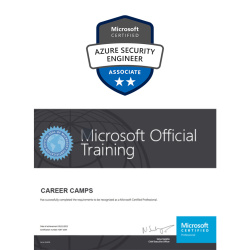
MCA Microsoft Azure Admin (w/ Azure Foundations) Certification Camp (2 Courses, 2 Exams, 2 Certs)
$4,495.00
The Microsoft Azure Administrator Boot Camp is designed to equip you with the skills and knowledge needed to implement, manage, and monitor a Microsoft Azure environment. During this intensive 6-day course, students will take two certification exams — AZ-900 and AZ-104 — earning both the Microsoft Certified: Azure Fundamentals and Microsoft Certified: Azure Administrator Associate credentials. We also offer the COMBO camp MCA Microsoft Azure Admin w/ MCE Solutions Architect COMBO Certification Camp which includes both the MCA and the MCE.
EXAMS INCLUDED
AZ-900: Microsoft Azure Fundamentals
AZ-104: Microsoft Azure Administrator
WHAT IS INCLUDED
| Airfare to/from Sarasota, FL | |
| 6 Nights of Lodging | |
| Ground Transportation | |
| Microsoft Training Books | |
| 2 Microsoft Exam Vouchers | |
| 1 Retake Voucher (per exam, if needed) | |
| Onsite Pearson Vue Test Center | |
| Microsoft Study Labs & Simulations |
LOCATIONS
Career Camps primary Microsoft Training campus (for individual students) is located in Sarasota, FL. Can’t travel to our facility? No problem! You will save on airfare, lodging and transportation. Just contact us and we will get you pricing to attend the class online live virtually from your work or home. If you do not see the location or class you are looking for, let us know! We have access to hundreds of classes and locations all across the United States and also offer corporate and group rates. If you have 5 students or more we can even come to you! With several partnerships in place, we are sure to have something to fit your needs. Whether you need to get MCA or MCE Certified, or get updated on Microsoft Windows Server 2022, we’ve got you covered.
- Description
- Additional information
- Our Facilities
- Why Choose Us
- Microsoft Azure Certifications
- Microsoft Gold Learning Partner
Description
The Microsoft Certified Azure Administrator 6-Day Training & Certification Boot Camp is designed to develop the practical skills needed for real-world Azure administration tasks. The course focuses on implementing, monitoring, and maintaining Microsoft Azure solutions, covering key services such as compute, storage, virtual machines, networking, Azure Active Directory, and security. To ensure a comprehensive understanding, the camp also includes essential Azure Fundamentals training, providing students with a solid end-to-end foundation in Azure administration.
Additional topics covered include the implementation, monitoring, and maintenance of Microsoft Azure solutions, with a focus on core services such as compute, storage, virtual machines, networking, Azure Entra ID (formerly Azure Active Directory), and security. The boot camp also includes essential Azure Fundamentals training to ensure students gain a comprehensive, end-to-end understanding of Azure administration.
During this intensive 6-day boot camp, students will complete two certification exams — AZ-900 and AZ-104 — earning both the Microsoft Certified: Azure Fundamentals and Microsoft Certified: Azure Administrator Associate credentials. This hands-on, live instructor-led training provides in-depth knowledge and practical skills for administering an Azure environment, while also preparing participants for the certification exams, which are taken during the course. Our training and certification program consistently delivers the highest pass rate among all Microsoft Official Training providers.
The Microsoft Certified Azure Administrator Associate boot camp is taught using Microsoft Official Courseware –
AZ-900T01: Microsoft Azure Fundamentals
AZ-104T00: Microsoft Azure Administrator
Skills Gained:
Manage Azure Subscriptions and Resources.
Configure and Secure Virtual Networking.
Administer Azure Identity and Access.
Deploy and Manage Virtual Machines.
Implement and Manage Storage Accounts.
Configure and Manage Microsoft Entra.
Implement and Manage Azure Governance.
Monitor and Back Up Azure Resources.
Manage Azure Applications and App Services.
Implement and Manage Azure Virtual Networks.
Work with Azure Resource Manager (ARM) Templates.
Topics Covered in this Official Boot Camp:
Describe Cloud Computing
Introduction to Microsoft Azure Fundamentals
Introduction to cloud computing
What is cloud computing
Describe the shared responsibility model
Define cloud models
Describe the consumption-based model
Describe the benefits of using cloud services
Describe the benefits of high availability and scalability in the cloud
Describe the benefits of reliability and predictability in the cloud
Describe the benefits of security and governance in the cloud
Describe the benefits of manageability in the cloud
Describe cloud service types
Describe Infrastructure as a Service
Describe Platform as a Service
Describe Software as a Service
Describe the core architectural components of Azure
What is Microsoft Azure
Get started with Azure accounts
Exercise – Explore the Learn sandbox
Describe Azure physical infrastructure
Describe Azure management infrastructure
Describe Azure compute and networking services
Describe Azure virtual machines
Exercise – Create an Azure virtual machine
Describe Azure virtual desktop
Describe Azure containers
Describe Azure functions
Describe application hosting options
Describe Azure virtual networking
Exercise – Configure network access
Describe Azure virtual private networks
Describe Azure ExpressRoute
Describe Azure DNS
Describe Azure storage services
Describe Azure storage accounts
Describe Azure storage redundancy
Describe Azure storage services
Exercise – Create a storage blob
Identify Azure data migration options
Identify Azure file movement options
Describe Azure identity, access and security
Describe Azure directory services
Describe Azure authentication methods
Describe Azure external identities
Describe Azure conditional access
Describe Azure role-based access control
Describe Zero Trust model
Describe defense-in-depth
Describe Microsoft Defender for Cloud
Describe cost management in Azure
Describe factors that can affect costs in Azure
Compare the Pricing and Total Cost of Ownership calculators
Exercise – Estimate workload costs by using the Pricing calculator
Exercise – Compare workload costs using the TCO calculator
Describe the Microsoft Cost Management tool
Describe the purpose of tags
Describe features and tools in Azure for governance and compliance
Describe the purpose of Microsoft Purview
Describe the purpose of Azure Policy
Describe the purpose of resource locks
Exercise – Configure a resource lock
Describe the purpose of the Service Trust portal
Describe features and tools for managing and deploying Azure resourcse
Describe tools for interacting with Azure
Describe the purpose of Azure Arc
Describe Azure Resource Manager and Azure ARM templates
Describe monitoring tools in Azure
Describe the purpose of Azure Advisor
Describe Azure Service Health
Describe Azure Monitor
Understand Microsoft Entra ID
Examine Microsoft Entra ID
Compare Microsoft Entra ID and Active Directory Domain Services
Examine Microsoft Entra ID as a directory service for cloud apps
Compare Microsoft Entra ID P1 and P2 plans
Examine Microsoft Entra Domain Services
Create, configure, and manage identities
Create, configure, and manage users
Exercise – assign licenses to users
Exercise – restore or remove deleted users
Create, configure, and manage groups
Exercise – add groups in Microsoft Entra ID
Configure and manage device registration
Manage licenses
Exercise – change group license assignments
Exercise – change user license assignments
Create custom security attributes
Explore automatic user creation
Describe the core architectural components of Azure
What is Microsoft Azure
Get started with Azure accounts
Exercise – Explore the Learn sandbox
Describe Azure physical infrastructure
Describe Azure management infrastructure
Azure Policy initiatives
Cloud Adoption Framework for Azure
Azure Policy design principles
Azure Policy resources
Azure Policy definitions
Evaluation of resources through Azure Policy
Secure your Azure resources with Azure role-based access control
What is Azure RBAC?
Knowledge check – What is Azure RBAC?
Exercise – List access using Azure RBAC and the Azure portal
Exercise – Grant access using Azure RBAC and the Azure portal
Exercise – View activity logs for Azure RBAC change
Allow users to reset their password with Microsoft Entra self-service password reset
What is self-service password reset in Microsoft Entra ID?
Implement Microsoft Entra self-service password reset
Configure virtual networks
Plan virtual networks
Create subnets
Create virtual networks
Plan IP addressing
Create public IP addressing
Associate public IP addresses
Allocate or assign private IP addresses
Interactive lab simulation
Configure network security groups
Implement network security groups
Determine network security group rules
Determine network security group effective rules
Create network security group rules
Implement application security groups
Interactive lab simulation
Host your domain on Azure DNS
What is Azure DNS?
Configure Azure DNS to host your domain
Exercise – Create a DNS zone and an A record by using Azure DNS
Dynamically resolve resource name by using alias record
Configure Azure Virtual Network peering
Determine Azure Virtual Network peering uses
Determine gateway transit and connectivity
Create virtual network peering
Extend peering with user-defined routes and service chaining
Manage and control traffic flow in your Azure deployment with routes
Identify routing capabilities of an Azure virtual network
Exercise – Create custom routes
What is an NVA?
Exercise – Create an NVA and virtual machines
Exercise – Route traffic through the NVA
Introduction to Azure Load Balancer
What is Azure Load Balancer?
How Azure Load Balancer works
When to use Azure Load Balancer
Introduction to Azure Application Gateway
What is Azure Application Gateway?
How Azure Application Gateway works
When to use Azure Application Gateway
Introduction to Azure Network Watcher
What is Azure Network Watcher?
How Azure Network Watcher works
When to use Azure Network Watcher
Configure storage accounts
Implement Azure Storage
Explore Azure Storage services
Determine storage account types
Determine replication strategies
Access storage
Secure storage endpoints
Configure Azure Blob Storage
Implement Azure Blob Storage
Create blob containers
Assign blob access tiers
Add blob lifecycle management rules
Determine blob object replication
Upload blobs
Determine Blob Storage pricing
Configure Azure Storage security
Review Azure Storage security strategies
Create shared access signatures
Identify URI and SAS parameters
Determine Azure Storage encryption
Create customer-managed keys
Apply Azure Storage security best practices
Configure Azure Files
Compare storage for file shares and blob data
Manage Azure file shares
Create file share snapshots
Implement soft delete for Azure Files
Use Azure Storage Explorer
Consider Azure File Sync
Introduction to Azure virtual machines
Compile a checklist for creating an Azure Virtual Machine
Exercise – Create a VM using the Azure portal
Describe the options available to create and manage an Azure Virtual Machine
Manage the availability of your Azure VMs
Back up your virtual machines
Configure virtual machine availability
Plan for maintenance and downtime
Create availability sets
Review update domains and fault domains
Review availability zones
Compare vertical and horizontal scaling
Implement Azure Virtual Machine Scale Sets
Create Virtual Machine Scale Sets
Implement autoscale
Configure autoscale
Configure Azure App Service plans
Implement Azure App Service plans
Determine Azure App Service plan pricing
Scale up and scale out Azure App Service
Configure Azure App Service autoscale
Configure Azure App Service
Implement Azure App Service
Create an app with App Service
Explore continuous integration and deployment
Create deployment slots
Add deployment slots
Secure your App Service app
Create custom domain names
Back up and restore your App Service app
Use Azure Application Insights
Configure Azure Container Instances
Compare containers to virtual machines
Review Azure Container Instances
Implement container groups
Review Azure Container Apps
Introduction to Azure Backup
What is Azure Backup?
How Azure Backup works
When to use Azure Backup
Protect your virtual machines by using Azure Backup
Azure Backup features and scenarios
Back up an Azure virtual machine by using Azure Backup
Exercise – Back up an Azure virtual machine
Restore virtual machine data
Introduction to Azure Monitor
Monitoring and Azure Monitor
Metrics and Logs
Azure Monitor Insights, visualizations, and actions
Improve incident response with Azure Monitor alerts
Explore the different alert types that Azure Monitor supports
Use metric alerts for alerts about performance issues in your Azure environment
Exercise – Use metric alerts to alert on performance issues in your Azure environment
Use log search alerts to alert on events in your application
Use activity log alerts to alert on events within your Azure infrastructure
Use action groups and alert processing rules to send notifications when an alert is fired
Exercise -Use an activity log alert and an action group to notify users about events in your Azure infrastructure
Analyze your Azure infrastructure by using Azure Monitor logs
Features of Azure Monitor logs
Create basic Azure Monitor log queries to extract information from log data
Exercise – Create basic Azure Monitor log queries to extract information from log data
Additional information
| Class Dates | 11/03/2025 – 11/08/2025 – Sarasota, FL, 12/01/2025 – 12/06/2025 – Sarasota, FL, 01/05/2026 – 01/10/2026 – Sarasota, FL, 02/02/2026 – 02/07/2026 – Sarasota, FL, 03/02/2026 – 03/07/2026 – Sarasota, FL, 04/06/2026 – 04/11/2026 – Sarasota, FL, 05/04/2026 – 05/09/2026 – Sarasota, FL, 06/01/2026 – 06/06/2026 – Sarasota, FL |
|---|
Our Facilities
CAREER CAMPS FACILITIES

CLASSROOM EQUIPMENT – Students work on a dedicated Dell Client Desktop with 32GB memory with 512GB SSD drives – All Labs are executed the extremely fast Microsoft Data Center Hosted Lab Environment.
CAMPUS INTERNET – The campus is connected with a 1Gbps (1,000 Mbps) Verizon Fios Business Connection which provides complete internet (including VPN) access for students.
COMMON AREA – Amenities including snacks, drinks (Coffee, 100% juices, sodas, etc) all complimentary.
LODGING – We use the Hyatt Place Lakewood Ranch. This “upgraded” hotel offers extremely comfortable beds, great breakfast and very fast internet access.
NEAR BY AMENITIES – Many shops, restaurants and grocery options are available within walking distance. Additionally – the hotel provided scheduled shuttle services. Restaurants like Bone Fish Grill, Ruby Tuesday’s, Five Guys, Chipotle, Quiznos, Chili’s and over 20 additional choices in the immediate area. All of these options are offered in a pedestrian walking village.
Why Choose Us
CAREER CAMPS DIFFERENCE
Career Camps provides an in-depth hands on learning environment. Our instructors teach using demonstrations and explain concepts beyond the scope of the courseware. The best instructors are contracted from all across the US. These professionals are real world consultants who actually implement these technologies. Career Camps knows our clients work in the “real world” and it only makes sense to have an instructor with the experience in the real world.
Facilities – Many of our competitors over-crowd classrooms by placing 2 to 3 students per desk and 20+ students per instructor. Often these companies “extend” the life of very old equipment with slow performance on the software used today. Our average class size is 8 students. Our facilities have the best equipment with the most comfortable, focused environment for learning.
Instructors – Our CEO, Chester Flake holds one of the rarest Microsoft Certifications – the Microsoft Certified Learning Consultant (MCLC) Certification. This certification reflects a commitment to make sure our instructors are also actively engaged in real world consulting projects. Students expect a professional who can answer questions and demonstrate the technology.
Face to Face Training – We believe the best way to interact and learn is face to face training. Many of our competitors which offer local training are simply providing students with headphones/mic to attend class with an instructor at a remote location.
Test Pass – We offer a free retake voucher (if needed) for each of the exams required for certification. Any training center offering a “100% pass guarantee” would have to use unethical practices or unlimited test vouchers (which is not likely or practical).
Distractions – Students often look for a “local” training center so they can be close to home and work. Boot camp requires a tremendous time commitment during the program. Long class hours combined with self study each evening. The goal of boot camp is to achieve certification in a fraction of the time. We strongly recommend students attend camp away from home and work in a focused, distraction free environment.
Boot Camp – Boot camp is an accelerated training focused on teaching technology and testing students on the official exams. Most training providers “added” boot camps to the existing standard training classes they offer. These training centers think a boot camp is just a regular class where you send the student home with a voucher on the last day. Career Camps administers exams throughout the camp. Equally important – not every trainer can teach a boot camp and not all courseware is designed for boot camp format. Our trainers know the boot camp format and our courseware is designed for accelerated learning.
Florida – Career Camps has one of the most scenic locations boasting some of the best weather in US. We believe students should have a comfortable and inviting atmosphere while attending these otherwise intense programs. We place our location, facilities and amenities up against that any competitor.
Microsoft Azure Certifications
Microsoft Job Role-based Azure Certifications
Microsoft has aligned Azure certifications and training to job roles – focusing on Admin, Dev or Architect.
Each certification requires 2 exams and no certification has any prerequisite certification requirements.
Microsoft Gold Learning Partner
Career Camps has developed a comprehensive training / delivery format which focuses on learning beyond the core content accessible to any Microsoft training provider. Our program incorporates interactive demonstrations with explanations which go beyond the content of the book. Additional content, videos, labs & demonstrations are provided to expand on advanced topics – providing additional insight and perspective.
Career Camps training is not the typical book & PowerPoint presentation found at any local training center.
As a Microsoft Certified Partner with Gold Learning Competency – we adhere to the strict guidelines, standards and requirements to use Microsoft’s exclusive curriculum. More over – our standards go beyond the “minimum requirements” set forth by Microsoft Learning.
We leverage our partnership benefits of courseware customization to build end to end technology training solutions. Students gain practical skills which can be implemented immediately.
At most training centers – learning starts on the first day of class and ends on the last day. Our boot camp training program is designed to offer resources before, during and after.
You May Also Like:
Related products
-
Azure Fundamentals Certification Camp (1 Course, 1 Exam, 1 Cert)
$995.00 Select options This product has multiple variants. The options may be chosen on the product page -
MCA Microsoft Azure Admin + MCE Solutions Architect Accelerated COMBO Certification Camp (2 Courses, 2 Exams, 2 Certs)
$4,995.00 Select options This product has multiple variants. The options may be chosen on the product page -
MCA Microsoft Azure Security Engineer Certification Camp (1 Course, 1 Exam, 1 Cert)
$2,995.00 Select options This product has multiple variants. The options may be chosen on the product page -
MCA Microsoft Azure Admin (w/ Foundations) + MCE Solutions Architect COMBO Certification Camp (3 Courses, 3 Exams, 3 Certifications)
$5,995.00 Select options This product has multiple variants. The options may be chosen on the product page







